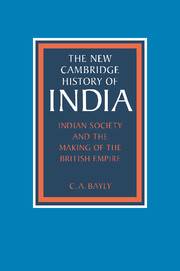Book contents
- Frontmatter
- Introduction
- 1 India in the eighteenth century: the formation of states and social groups
- 2 Indian capital and the emergence of colonial society
- 3 The crisis of the Indian state, 1780–1820
- 4 The consolidation and failure of the East India Company's state, 1818–57
- 5 Peasant and Brahmin: consolidating ‘traditional’ society
- 6 Rebellion and reconstruction
- Conclusion: the first age of colonialism in India
- Glossary of indian terms
- Bibliographical essay
- Index
- THE NEW CAMBRIDGE HISTORY OF INDIA
- Plate Section"
- References
4 - The consolidation and failure of the East India Company's state, 1818–57
Published online by Cambridge University Press: 28 March 2008
- Frontmatter
- Introduction
- 1 India in the eighteenth century: the formation of states and social groups
- 2 Indian capital and the emergence of colonial society
- 3 The crisis of the Indian state, 1780–1820
- 4 The consolidation and failure of the East India Company's state, 1818–57
- 5 Peasant and Brahmin: consolidating ‘traditional’ society
- 6 Rebellion and reconstruction
- Conclusion: the first age of colonialism in India
- Glossary of indian terms
- Bibliographical essay
- Index
- THE NEW CAMBRIDGE HISTORY OF INDIA
- Plate Section"
- References
Summary
The East India Company rose to power because it had provided a secure financial base for its powerful mercenary army. The land revenues of Bengal, combined with the capital - Indian as much as European – generated in the coastal trading economy, allowed the Company's Indian operations to sustain the massive debts incurred in its fight to the finish with the Indian kingdoms. However, political dominion did not solve the Company's financial problems. The ominous presence and constant pressure of this part-oriental, part-European state continued to tempt petty rulers within and outside its domains into revolt. Though aspects of the social and political conflict which had drawn the Company into expansion were suppressed under its rule, so too was much of the economic dynamism which had given rise to that conflict. India's huge agricultural economy was not performing well enough to underwrite the costs of European dominion. The East India Company's rule widely came to be seen as a dismal failure long before the Great Rebellion of 1857 blew up its foundations. This chapter demonstrates how the British maintained their fragile dominance over the subcontinent in the early years of the nineteenth century before considering this economic impasse and the attempts of administrators to escape from it.
MILITARY DOMINATION AND POLITICAL SUASION
The development of a cavalry arm and efficient siege methods for use against small fortresses put the Company on the offensive again throughout India. The British could begin to suppress what Arthur Wellesley called ‘the freebooting system’ and corral those armed plunderers – Pindaris, ‘Arabs’, and Rohillas – who threatened the land-revenue yield in western and central India.
Keywords
- Type
- Chapter
- Information
- Indian Society and the Making of the British Empire , pp. 106 - 135Publisher: Cambridge University PressPrint publication year: 1988



